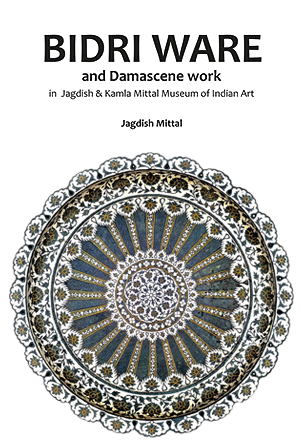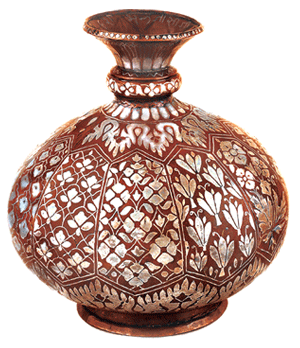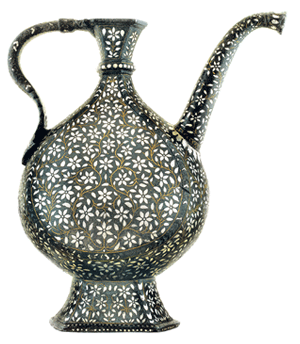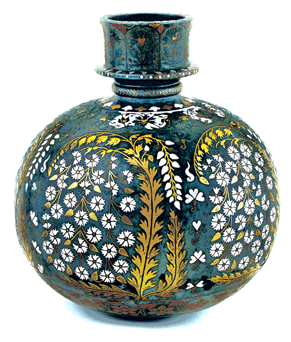- Publisher's Note
- Editorial
- Love of Life (that) Spills Over
- A Continuing Multiplication
- From Painting to Print
- Intimate Involvement
- Portrait of the Artist as an Old Man
- (Hi)Story of the Garhi Printmaking Studios, New Delhi
- Surinder Chadda
- Ramendranath Chakravorty
- Group 8
- Mother and Child: A Screenplay
- Straddling Worlds
- A Brief History of Printmaking at Santiniketan
- Vignettes from History
- Southern Strategies
- The Forgotten Pioneer: Rasiklal Parikh
- Printmaking in the City Of Joy
- Amitabha Banerjee: His Art and Aesthetic Journey
- Local Style and Homogenizing trends: Early Medieval Sculpture in Galaganatha
- English China: Delicate Pallid Beauty
- The Beauty of 'Bilal'
- Photo Essay
- The Way of The Masters: The Great Artists of India 1100 –1900
- Striving Towards Objectivity
- The Art of Sculpting In the Contemporary Times
- An Artistic Framework for an Alternative to Ecology
- Bidriware and Damascene Work in Jagdish and Kamla Mittal Museum of Indian Art
- A Lowdown on the Print Market
- The 'bubble' and the 'wobble'
- What Happened and What's Forthcoming
- Art Bengaluru
- Art Events Kolkata: June – July 2011
- Musings from Chennai
- Mumbai Art Sighting
- Previews
- In the News
- Christie's Jewellery Auction at London, South Kensington
ART news & views
Bidriware and Damascene Work in Jagdish and Kamla Mittal Museum of Indian Art
Volume: 3 Issue No: 19 Month: 8 Year: 2011
Book Review
by Koeli Mukherjee Ghose
 Author: Jagdish Mittal
Author: Jagdish Mittal
Genre: Art History
Published by: Jagdish and Kamla Mittal Museum of Indian Art
Padmasree Jagdish Mittal in his new book titled Bidri Ware and Damascene Work in Jagdish and Kamla Mittal Museum, Hyderabad; recalls his first two acquisitions in Hyderabad in 1965. The passion for collecting Bidriware subsequently led him to the study of about one thousand Bidris.
Jagdish Mittal, born in 1925, was trained as an artist in Santiniketan, well known as an art collector, art historian; and for his inexhaustible knowledge on Indian art. He is the Principal Trustee of the Jagdish and Kamla Mittal Museum of Indian Art, Hyderabad, a Public Trust, to which he and his artist wife, Kamla, gifted their unique collection in 1976. He was awarded the Padma Shri by the President of India in 1990. In 1969, Andhra Pradesh Lalit Kala Akademi published his book Andhra Paintings of the Ramayana. He has delivered lectures on Indian art at various museums and art institutions in India and abroad; presented papers at International Seminars, and his scholarly articles have been published in prominent books and journals on Indian art.
His exhaustive research brings to light, crucial information that is seldom available in other museums and private collections. The book offers a resourceful history of the Bidriware, its origin at Bidar, its metal alloy, various techniques applied for its making, variety of inlay, ingredients of the 'blackening paste', sequence of shapes and designs, indicating the tell tale signs for precision in dating, along with a detailed information on Bidris from various regions, such as Lucknow, Murshidabad and Purnea, produced in later years.
The book offers a resourceful history of the Bidriware, its origin at Bidar, its metal alloy, various techniques applied for its making, variety of inlay, ingredients of the 'blackening paste', sequence of shapes and designs, indicating the tell tale signs for precision in dating, along with a detailed information on Bidris from various regions, such as Lucknow, Murshidabad and Purnea, produced in later years.
The book reveals the best works of the 18th -19th centuries and an extensive compilation of the shapes and design-types of these Bidriwares, in the course of this period. The earliest work that has been identified dates back to October 1634, the others are dated 1818 and 1859, indicating these three dated examples of Bidri pieces - as crucial for the future study of Bidriware, the author highlights the importance of this book, in terms of history and technique of a traditional craft. He also brings to notice three rare examples of damascene work, a similar technique of silver, brass or gold inlay-work on iron. He informs that these Bidris were exhibited in the Victoria & Albert Museum (1982), the Metropolitan Museum of Art, New York (1985); and the Boston Museum (1985).
In the preface the author narrates his first finding of the Bidri pieces in Hyderabad and his gradual appreciation and study of the metalcraft, its making and its history “I handled a Bidri object for the first time in 1951, when I came to Hyderabad for an exhibition of paintings by Kamla, my wife, and I. One day, while strolling in a lane, we noticed a wayside stall selling discarded household articles. Amongst these were two Bidri hookah bases, which I bought for ten rupees. I was instantly enamoured by the intricate silver inlay on their black body. Sometime back, I had read about Bidri in the well-known book Indian Art at Delhi, 1903, by Sir George Watt, catalogue of an exhibition. I was thrilled to own these original objects, and I was inquisitive to know their mode of manufacture, history, and their centre of production. Although Watt's book provided some basic information about this metalware, I needed more details. In the same month I saw several Bidris in the Salar Jung Museum, Hyderabad, which was being set up. My search for Bidri objects led me to the late Harish Chandra Agarwala, a leading local antique dealer in art, especially Indian metal objects. Each time I met him he showed me dozens of Bidris he had acquired, and told me about their technique, and their centre of production, Bidar. I regularly acquired from him Bidris whenever he found a good lot.”
its making and its history “I handled a Bidri object for the first time in 1951, when I came to Hyderabad for an exhibition of paintings by Kamla, my wife, and I. One day, while strolling in a lane, we noticed a wayside stall selling discarded household articles. Amongst these were two Bidri hookah bases, which I bought for ten rupees. I was instantly enamoured by the intricate silver inlay on their black body. Sometime back, I had read about Bidri in the well-known book Indian Art at Delhi, 1903, by Sir George Watt, catalogue of an exhibition. I was thrilled to own these original objects, and I was inquisitive to know their mode of manufacture, history, and their centre of production. Although Watt's book provided some basic information about this metalware, I needed more details. In the same month I saw several Bidris in the Salar Jung Museum, Hyderabad, which was being set up. My search for Bidri objects led me to the late Harish Chandra Agarwala, a leading local antique dealer in art, especially Indian metal objects. Each time I met him he showed me dozens of Bidris he had acquired, and told me about their technique, and their centre of production, Bidar. I regularly acquired from him Bidris whenever he found a good lot.”
Jagdish Mittal extends an elaborate discussion on the origin of Bidri, the speciality of the metal alloy its preparation and process of manufacture. Bringing the artisans in context, he mentions “The Bidri craftsmen did not belong to a hereditary artisan caste, like the goldsmiths, coppersmiths, ironsmiths, carpenters or weavers who, according to the age-old Indian tradition, belonged to a particular caste of artisans. Men of any caste, Hindu or Muslim, could learn one of its specialized processes of production. In this industry, the role of the skilled designer and inlayer was above all others because his contribution was significant for the quality of work.”
He explicates the different types of inlay, the process of executing the designs and particulars of ingredients such as the blackening paste, used to “impart black colour to the surface of the Bidri wares”. The author, describes the fascinating variety of objects in Bidri, and their shapes, accompanied with plates and illustrations in painstakingly created line drawings; he provides an extensive comparison of the easy and difficult procedures and explaining each of the Tarkashi, Mahtabi, Aftabi, Zarnishan and Zarbuland techniques, in great detail.
used to “impart black colour to the surface of the Bidri wares”. The author, describes the fascinating variety of objects in Bidri, and their shapes, accompanied with plates and illustrations in painstakingly created line drawings; he provides an extensive comparison of the easy and difficult procedures and explaining each of the Tarkashi, Mahtabi, Aftabi, Zarnishan and Zarbuland techniques, in great detail.
He reveals the repertoire of decorative motifs inscribed on the Bidri pieces by bringing in to discussion, the evolution of the designs from early pieces, the influences from “Mughal - type decorations of naturalistic flowers” of 1620. He mentions Jehangir's visit to Kashmir, and the commissioning of Ustad Mansur to record the inspiring form and colour of the flowers of Kashmir, in his sketches. Jagdish Mittal's remarkable grasp on history imbibes his account with an ease of story telling as he moves on to the period of Shah Jahan (1628 -58) and his appreciation of the floral motif appropriated in architecture,textiles, borders of paintings of his time. The author mentions, that in Bidar the same floral motifs appeared with some modifications, reflecting the “Persianate - Deccani ornaments”, “palmettes and arabesques”. Jagdish Mittal's deep acquaintance of the Deccan, its History and culture reflects in his narration as he describes the Deccani motif with passion - “blooming with explosive force”. Often Bidriwares had inscriptions of Arabic calligraphy of very high quality, rendering the piece special, the author elucidates the significance of such pieces and their aesthetic value. He concludes by creating and establishing a historical chronology through the study of the earliest depictions of Bidris in Indian painting and dating of the Bidri work.
The author draws a comparative sketch of the damascene work from Lucknow, Murshidabad and Purnea to that of the Bidris of the Deccan. Names of the artisans, and historical anecdotes creates a vibrant experience. A sensitive exertion of conveying the essence of the Bidri work, in the book, is reflected in the refinement of it's design. Photographs of drawings and miniatures substantiate the existence of Bidris in historical periods.  The author’s style of easy narration, quality of plates and the clear spacing of texts, favours the reader to be absorbed in the world of art and history that the author creates, transporting the flavour of the historical references alongside the meticulous artistry of the traditional craft.
The author’s style of easy narration, quality of plates and the clear spacing of texts, favours the reader to be absorbed in the world of art and history that the author creates, transporting the flavour of the historical references alongside the meticulous artistry of the traditional craft.
Jagdish Mittal through his articulation has tried to promulgate the notion of cultural and historical value of the Bidriwares; he poignantly quotes in the Wall Street journal of Asia - “In November 2006, the Indian government gave Bidri a Geographical Indication – an intellectual property strategy under World Trade Organisation rules, directed at adding brand value and preventing cheap replicas.”
The much awaited book is distinctly vital in providing detailed investigation of all characteristics of the craft of the Bidriware. The entire collection of fifty Bidri pieces in the Museum are published in colour, accompanied with detailed notes on each piece, references and a select bibliography. A map and a number of text figures offer additional help to derive reference from the book. Prophecied as imperative for a deeper study of this unique art form of the Deccan, each of the 153 pages of the book is delightful and informative.
Photographs courtesy: Jagdish and Kamla Mittal Museum of Indian Art